Highland Homes Holdings Bundle
Can Highland Homes Continue Its Ascent in the Competitive Housing Market?
Highland Homes, a privately held giant in the real estate development arena, has established a strong presence since its inception in 1985. Operating primarily in master-planned communities across key markets, the company has consistently adapted to meet diverse housing demands. But what does the future hold for this prominent builder?
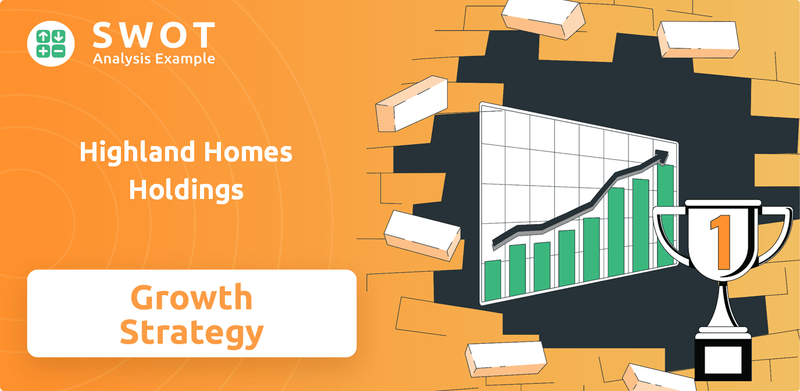
This analysis delves into the Highland Homes Holdings SWOT Analysis, exploring its growth strategy and future prospects within the dynamic housing market. We'll examine its expansion plans, innovation strategies, and financial planning to understand how Highland Homes aims to maintain its competitive advantages. Understanding Highland Homes Holdings' approach offers valuable insights for investors and analysts seeking to navigate the evolving landscape of real estate and understand the impact on local economies.
How Is Highland Homes Holdings Expanding Its Reach?
Highland Homes' expansion initiatives are strategically focused on deepening its presence in high-growth markets and entering new, complementary regions. The company concentrates on building single-family homes within master-planned communities, a strategy that has proven successful in attracting buyers seeking amenity-rich environments. This approach allows them to capitalize on strong population growth and housing demand in key areas.
In 2024 and 2025, the company continues to prioritize markets like Central Florida, Tampa Bay, and the Dallas-Fort Worth area. These regions offer robust opportunities for expansion. The company leverages its established supply chains and developer relationships to facilitate growth within these areas.
To further its growth, Highland Homes is exploring opportunities to expand its product offerings within these markets. This may include introducing new home designs or community types that cater to evolving buyer preferences, such as increased demand for flexible living spaces or energy-efficient homes. The company's historical growth trajectory suggests a disciplined approach to expansion, likely through organic growth or strategic land acquisitions.
Highland Homes concentrates on high-growth markets like Central Florida, Tampa Bay, and Dallas-Fort Worth. These areas are chosen for their strong population growth and housing demand. This regional focus allows the company to leverage its established supply chains and relationships, ensuring efficient operations and strategic growth.
The company is exploring opportunities to expand its product offerings within existing markets. This includes new home designs and community types to meet evolving buyer preferences. The goal is to cater to the increasing demand for flexible living spaces and energy-efficient homes, ensuring they remain competitive.
Highland Homes is also considering partnerships to enhance the homebuying experience. This includes collaborations with smart home technology providers and financing institutions. These partnerships aim to improve customer satisfaction and provide added value, driving both sales and customer loyalty.
Due to its private status, specific details on new market entries or mergers and acquisitions for 2025 are not publicly disclosed. However, the company's historical growth suggests a disciplined approach. This involves organic growth within new phases of existing communities or strategic land acquisitions in high-growth submarkets. The company's approach is measured and strategic.
The company's expansion strategy also involves considering the diversification of revenue streams. This is achieved through exploring partnerships that enhance the homebuying experience, such as collaborations with smart home technology providers or financing institutions. For more information on the competitive landscape, you can refer to Competitors Landscape of Highland Homes Holdings.
Highland Homes' expansion strategy focuses on strategic market selection and product diversification. It prioritizes high-growth areas and adapts to changing buyer preferences. The company's approach is designed to ensure sustainable growth and maintain a competitive edge.
- Focus on high-growth markets such as Central Florida and Dallas-Fort Worth.
- Diversify product offerings to meet evolving buyer preferences.
- Explore strategic partnerships to enhance the homebuying experience.
- Maintain a disciplined approach to expansion through organic growth and strategic acquisitions.
Highland Homes Holdings SWOT Analysis
- Complete SWOT Breakdown
- Fully Customizable
- Editable in Excel & Word
- Professional Formatting
- Investor-Ready Format
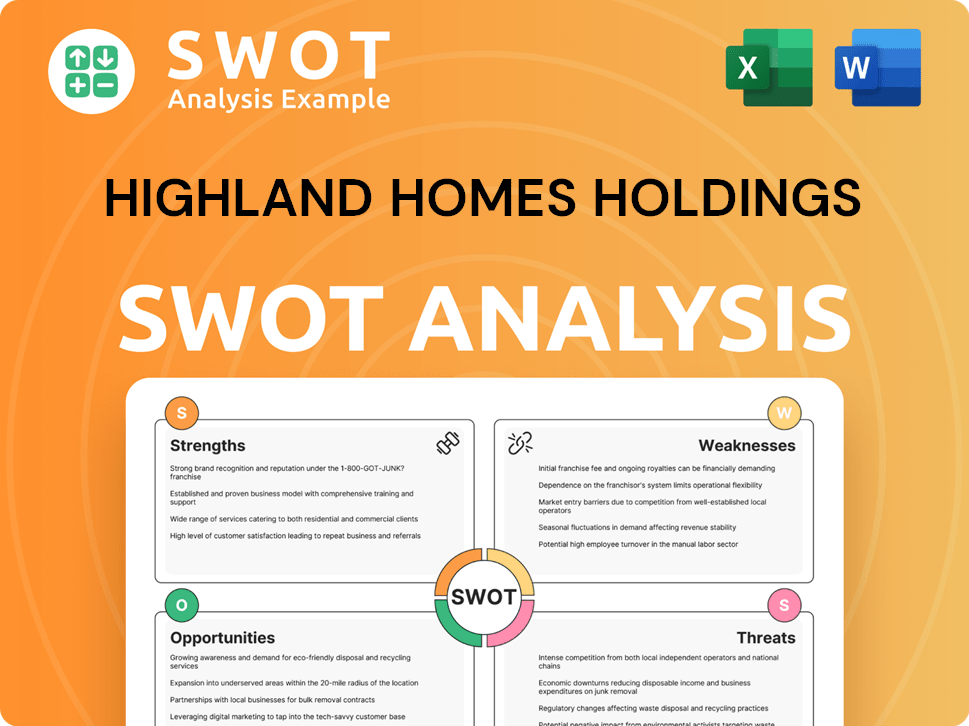
How Does Highland Homes Holdings Invest in Innovation?
Understanding the evolving needs and preferences of homebuyers is crucial for any real estate developer. For Highland Homes Holdings, this means staying ahead of housing market trends and adapting to changing customer expectations. The company's success hinges on its ability to deliver homes that meet the demands of today's buyers, including features like smart home technology and energy efficiency.
Customer preferences are increasingly focused on personalization and sustainability. Buyers are looking for homes that reflect their individual styles and values, which includes options for customization and eco-friendly features. This shift requires developers to embrace innovation and offer a variety of choices.
The company's focus on master-planned communities also plays a role in understanding customer needs. These communities often integrate amenities and technologies that enhance the living experience, catering to a desire for convenience and community.
The company leverages technology to improve its homebuilding processes. This includes using advanced construction management software to streamline project timelines and improve cost efficiency. The integration of smart home features and energy-efficient systems is a key aspect of its innovation strategy.
The company incorporates sustainable building practices to meet the growing demand for energy-efficient homes. This includes using eco-friendly materials and designs that reduce environmental impact. This approach enhances the company's appeal in the housing market.
The company offers a variety of home designs and personalization options. This flexibility allows the company to meet the evolving demands of the housing market. Customization is a key factor in attracting buyers.
The emphasis on master-planned communities supports the adoption of integrated technological solutions. These communities often feature amenities and technologies that enhance community living. This approach enhances the overall living experience.
The company's adaptable design and construction process allows it to incorporate new trends and customer preferences efficiently. This adaptability helps the company remain competitive in regions like Central Florida, Tampa Bay, and Dallas-Fort Worth. This responsiveness is crucial for sustained growth.
While specific details on R&D investments are not publicly available, the company's focus on delivering high-quality, personalized homes implies an ongoing commitment to incorporating modern building techniques and materials. This commitment is essential for innovation.
The company's innovation strategy is a key component of its Highland Homes Growth Strategy. By incorporating advanced construction management software, smart home features, and energy-efficient systems, the company aims to improve customer experience and drive sustained growth. The company's ability to offer a variety of home designs and personalization options further supports its competitive position in the Real Estate Development market. For a deeper dive into the company's overall strategy, you can refer to a comprehensive Company Analysis of Highland Homes Holdings.
The company focuses on several key areas to enhance its homebuilding process and customer experience. These include integrating smart home technology, implementing energy-efficient systems, and utilizing advanced construction management software.
- Smart Home Integration: Incorporating features like smart thermostats, security systems, and lighting control to enhance convenience and energy efficiency.
- Energy Efficiency: Using sustainable materials and designs to reduce environmental impact and lower homeowner costs.
- Construction Management Software: Streamlining project timelines and improving cost efficiency through the use of advanced software solutions.
- Customization Options: Providing a variety of home designs and personalization options to meet individual customer preferences.
- Master-Planned Communities: Developing communities that integrate technological solutions and enhance community living.
Highland Homes Holdings PESTLE Analysis
- Covers All 6 PESTLE Categories
- No Research Needed – Save Hours of Work
- Built by Experts, Trusted by Consultants
- Instant Download, Ready to Use
- 100% Editable, Fully Customizable
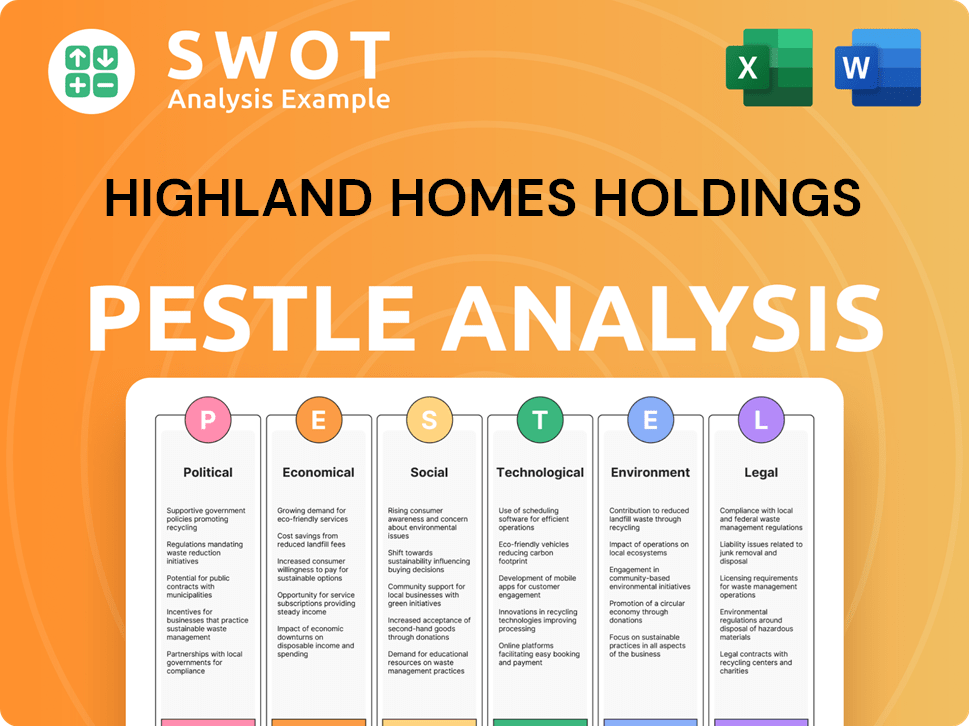
What Is Highland Homes Holdings’s Growth Forecast?
As a privately held entity, detailed financial data for Highland Homes Holdings is not publicly available. However, insights into its financial outlook can be derived from industry trends and the company's operational focus. The residential construction sector, particularly in the single-family home market, has demonstrated resilience. This is especially true within master-planned communities, which are a key area of focus for the company.
The Dallas-Fort Worth area, a significant market for Highland Homes, saw robust new home sales in 2024, with projections indicating continued strength into 2025. This points to a strong demand environment. Similarly, the Central Florida housing market continues to experience growth, supporting a positive outlook for builders in the region. This is a crucial factor when considering the Target Market of Highland Homes Holdings.
Highland Homes' strategy of offering diverse home designs and personalization options likely contributes to healthy profit margins. This approach caters to various buyer segments and potentially allows for premium pricing on customized features. Investment levels are expected to be focused on land acquisition and development within new and existing master-planned communities. The company's long-term financial goals likely align with sustainable growth, driven by consistent new home sales and efficient operational management.
While specific financial figures remain private, the company's performance is closely tied to housing market trends. The housing market in the Dallas-Fort Worth area, a key market for Highland Homes, saw a significant increase in new home sales in 2024. This indicates strong demand and supports the company's revenue generation.
The Central Florida housing market is experiencing consistent growth. This provides a favorable environment for builders like Highland Homes. The company likely plans to expand its presence in this region, capitalizing on the increasing demand for new homes. This expansion is a key part of their future prospects.
Offering a variety of home designs and personalization options is a significant competitive advantage. This strategy allows Highland Homes to cater to diverse buyer segments. It also potentially enables premium pricing on customized features, which supports healthy profit margins.
Highland Homes focuses on developing new communities within master-planned areas. These developments are crucial for driving new home sales and expanding market share. These new communities are central to the company's growth strategy.
Market share analysis is crucial for understanding the company's position in the housing market. While specific market share data is not publicly available, the company's presence in high-growth areas like Dallas-Fort Worth and Central Florida suggests a solid market position. The company's focus on master-planned communities likely helps to maintain and grow its market share.
- The company's strategic focus on master-planned communities is a key factor in maintaining and growing its market share.
- Highland Homes' ability to offer diverse home designs and personalization options contributes to its competitive advantage.
- Expansion in high-growth areas like Dallas-Fort Worth and Central Florida supports the company's market share goals.
- The overall housing market trends in these regions provide a favorable environment for growth.
Highland Homes Holdings Business Model Canvas
- Complete 9-Block Business Model Canvas
- Effortlessly Communicate Your Business Strategy
- Investor-Ready BMC Format
- 100% Editable and Customizable
- Clear and Structured Layout
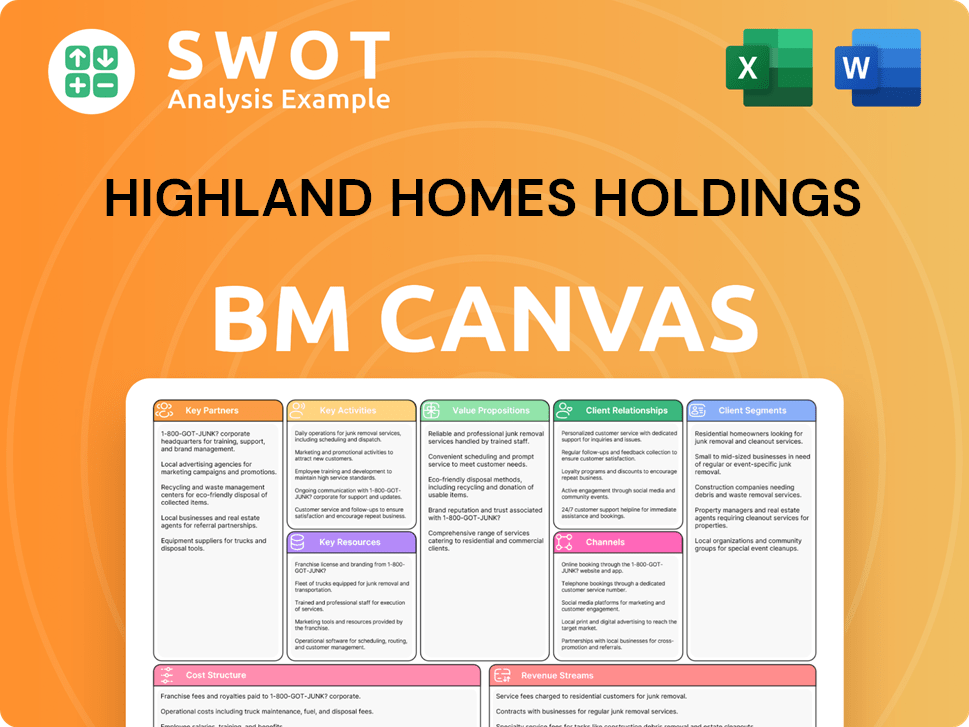
What Risks Could Slow Highland Homes Holdings’s Growth?
The Highland Homes Holdings faces several potential risks and obstacles that could affect its growth ambitions. These challenges include intense competition, regulatory changes, and supply chain vulnerabilities. Understanding these potential hurdles is critical for evaluating the company's Highland Homes Growth Strategy and assessing its Highland Homes Future Prospects.
Market competition remains a significant concern, with numerous local and national home builders vying for market share. Regulatory changes, particularly those related to zoning and building codes, can introduce delays and increase costs. Supply chain issues, such as fluctuations in material costs or labor shortages, also pose operational risks.
Technological disruption and internal resource constraints further complicate the landscape. Adapting to new construction methods and digital platforms is crucial. Internal issues, such as the availability of skilled labor, could also hinder expansion efforts. The Real Estate Development sector is dynamic, and Highland Homes Holdings must navigate these challenges effectively.
The Housing Market Trends show increased competition. Numerous builders compete in key markets like Dallas-Fort Worth and Central Florida. Understanding the competitive landscape is essential for Highland Homes Holdings to maintain or grow its market share.
Changes in zoning laws, environmental regulations, and building codes can cause delays and increase costs. Interest rate fluctuations influence buyer affordability and mortgage demand. These factors can significantly impact sales volumes.
Fluctuations in material costs and labor shortages pose ongoing operational risks. The cost of building materials, such as lumber and steel, can be volatile. These risks can affect project timelines and profitability.
Failure to adapt to new construction methods, smart home technologies, and digital sales platforms could be detrimental. Embracing technological advancements is crucial for long-term success. Company Analysis shows this is a growing trend.
The availability of skilled labor and effective project management can hinder expansion. Efficient operations and skilled workforce are critical for managing projects. These constraints can limit growth.
Economic downturns and changes in consumer confidence can impact the housing market. Interest rate hikes can decrease affordability and demand. These factors can directly affect Highland Homes Holdings financial performance.
Highland Homes Holdings likely mitigates risks through strategic land banking and diversifying product offerings. Maintaining strong relationships with suppliers and subcontractors is also crucial. The company's focus on master-planned communities can offer stability.
The homebuilding industry's ability to adapt through diversified offerings and efficient operations is important. While specific data is unavailable due to its private nature, the company's resilience is evident. To learn more, you can read about the Brief History of Highland Homes Holdings.
Highland Homes Holdings Porter's Five Forces Analysis
- Covers All 5 Competitive Forces in Detail
- Structured for Consultants, Students, and Founders
- 100% Editable in Microsoft Word & Excel
- Instant Digital Download – Use Immediately
- Compatible with Mac & PC – Fully Unlocked
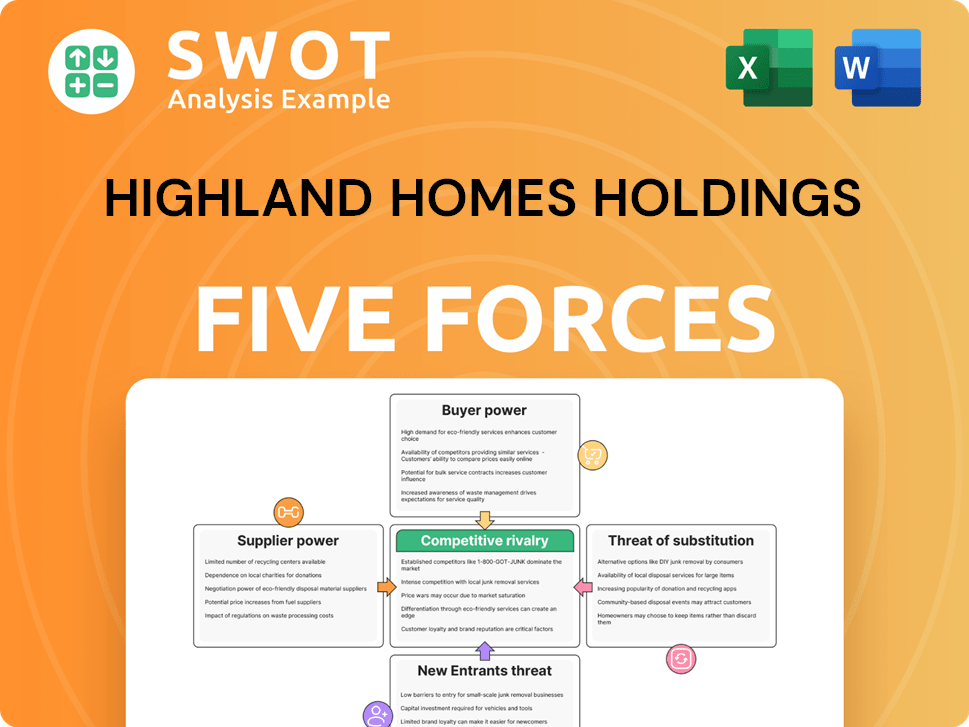
Related Blogs
- What are Mission Vision & Core Values of Highland Homes Holdings Company?
- What is Competitive Landscape of Highland Homes Holdings Company?
- How Does Highland Homes Holdings Company Work?
- What is Sales and Marketing Strategy of Highland Homes Holdings Company?
- What is Brief History of Highland Homes Holdings Company?
- Who Owns Highland Homes Holdings Company?
- What is Customer Demographics and Target Market of Highland Homes Holdings Company?
Disclaimer
All information, articles, and product details provided on this website are for general informational and educational purposes only. We do not claim any ownership over, nor do we intend to infringe upon, any trademarks, copyrights, logos, brand names, or other intellectual property mentioned or depicted on this site. Such intellectual property remains the property of its respective owners, and any references here are made solely for identification or informational purposes, without implying any affiliation, endorsement, or partnership.
We make no representations or warranties, express or implied, regarding the accuracy, completeness, or suitability of any content or products presented. Nothing on this website should be construed as legal, tax, investment, financial, medical, or other professional advice. In addition, no part of this site—including articles or product references—constitutes a solicitation, recommendation, endorsement, advertisement, or offer to buy or sell any securities, franchises, or other financial instruments, particularly in jurisdictions where such activity would be unlawful.
All content is of a general nature and may not address the specific circumstances of any individual or entity. It is not a substitute for professional advice or services. Any actions you take based on the information provided here are strictly at your own risk. You accept full responsibility for any decisions or outcomes arising from your use of this website and agree to release us from any liability in connection with your use of, or reliance upon, the content or products found herein.